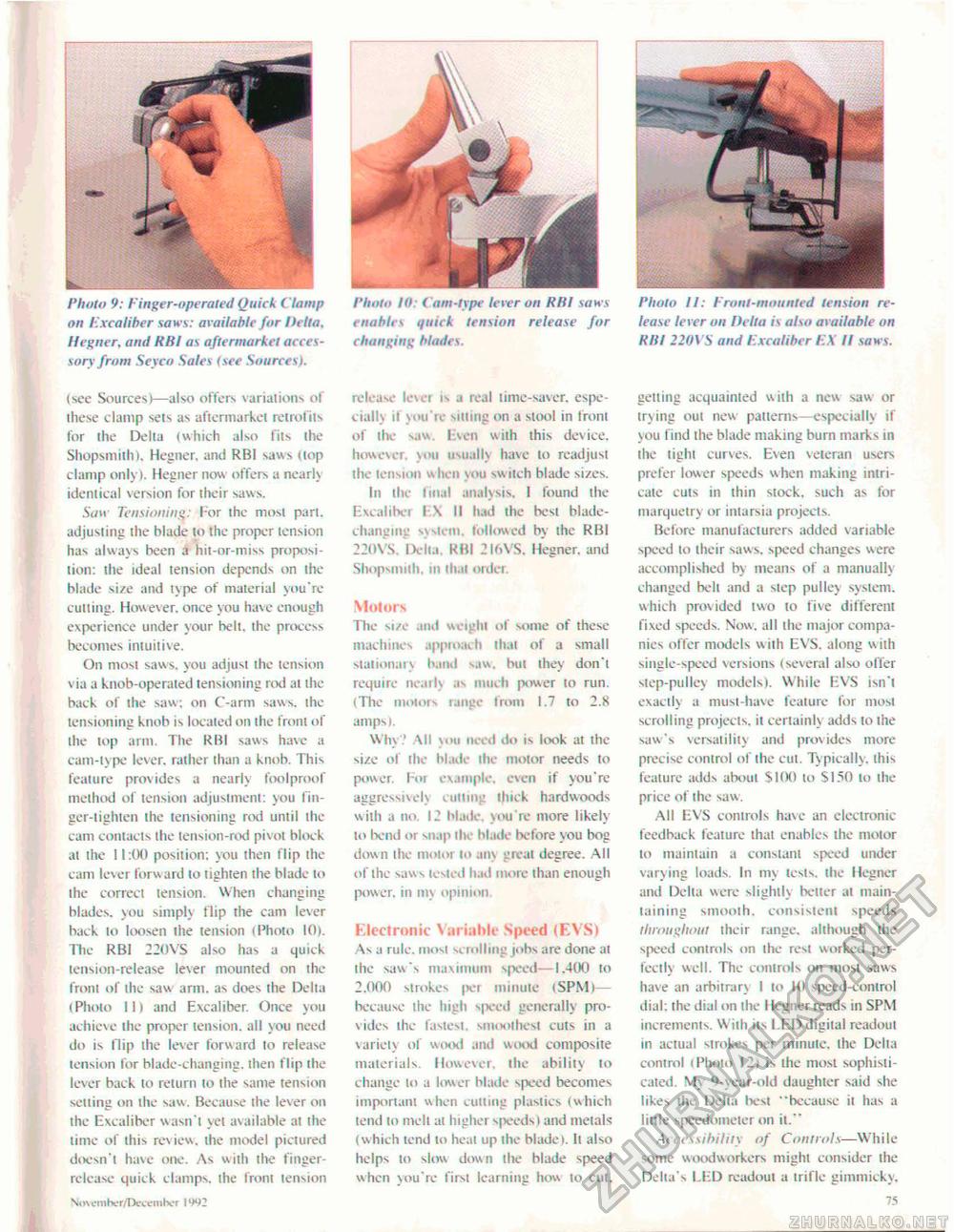Woodworker's Journal 1985-9-6, страница 75
Photo 9: Finger-operated Quick ( lamp on Excaliber saws: available for Delta. Hegner, and RBI as aftermarket accessory from Seyco Sales (see Sources). I sec Sources!—also offers variations of these clamp sets as aftermarket retrofits for the Delta (which also fits the Shopsmilh). Hegner. and RBI saws (top clamp only). Hegner now offers a nearly identical version for their saws. San Tensioning: t or the most pari, adjusting the blade to ihe proper tension has always been a hit-nr-miss proposition: the ideal tension depends on the blade si/e and type of material you're cutting. However, once you have enough experience under your belt, the process becomes intuitive. On most saws, you adjust the tension via a knob-operated tensioning rod at ihe back of ihe saw: on C-arm saws, ihe tensioning knob is located on the front of the lop arm. The RBI saws haw a cam-type lever, rather lhan a knob. This feature provides a nearly foolproof method of tension adjustment: you finger-lighten ihe tensioning rod until the cam contacts the tensiOn-rod pivot block al the 11:00 position: you then flip the cam lever forw ard to lighten the blade to the correct tension. When changing blades, you simply flip the cam lever hack to loosen the tension (Photo 10). The RBI 220YS also has a quick tension-release lever mounted on the front of ihe saw arm. as does the Delia (Photo II) and Excaliber. Once you achieve ihe proper tension, ail you need do is flip ihe lever forward to release tension for blade-changing, then flip the lever back io return to the same tension setting on the saw. Because the lever on ihe Excaliber wasn't yet available at ihe time of this review, the model pictured doesn't have one. As with the finger-release quick clamps, the front tension \i>veraher/Dc<.-emher IW Photo 10: Cam-type lever on RHI saws enables quick tension release for changing blades. release lever is a real lime-saver, especially if \ nil"re sining on a slool in front of die saw. Even with this device, however, you usually have io readjust the tension when you switch blade sizes. In ihe final analysis. I found the Excalibci EX II had ihe besi blade-changing system, followed by the RBI 220VS. Delta RBI 2I6VS. Hegner. and Shopsmilh. in iti.it order Motors The M/e ami weight ol some of these machines approach that of a small stationary band saw, but ihey don't require nearly is much power to run. (The motors range from 1.7 to 2.8 amps). Why.' \ll you need do is look at the si/e of the Wade ihe motor needs to power. I hi example, even if you're aggressively cutting thick hardwoods with a no, 12 blade, you're more likely lo bend or snap like Made before you bog down the motor lo any great degree. All of the saws tested hail more than enough [lower, in my opinion Electronic Variable Speed (EVS) As a rule, most scrolling jobs are done at the saw's maximum speed—1.400 to 2,000 strokes per minute (SPM)— because the high speed generally provides ihe fastest, smoothest cuts in a variety of wood and wood composite materials. However, the ability to change lo a lower blade speed becomes important when culling plastics (which tend lo melt ai higher speeds) and metals (which tend to heat up ihe blade). Il also helps lo slow down ihe blade speed when you're first learning how to cut. Photo II: Front-mounted tension release lever on Delta is also available on RBI 220VS and Fxcaliber EX II saws. gelling acquainted wilh a new saw or trying oul new paiterns—especially if you find ihe blade making burn marks in ihe light curves. Even veteran user-prefer lower speeds when making intricate cuts in thin stock, such as for marquetry or intarsia projects. Before manufacturers added variable speed to their saws, speed changes were accomplished by means of a manually changed belt and a step pulley system, which provided two to five different fixed speeds. Now. all the major companies offer models with EVS, along w ith single-speed versions (several also offer step-pulley models). While EVS isn't exactly a must-have fcalurc for most scrolling projects, ii certainly adds to ihe saw's versatility and provides more precise control of ihe cut. Typically, this feature adds aboul $100 to SI50 to the price of ihe saw. All EVS controls have an electronic feedback feature thai enables the motor to maintain a constant speed under varying loads. In my lesis. the Hegner and Delia were slightly better al maintaining smooth, consistent speeds throughout their range, although ihe speed controls on the rest worked perfectly well. The controls on most saws have an arbitrary I to 10 speed-control dial: the dial on the Ilegner reads in SPM increments. Wilh its I.ED digital readout in actual strokes per minute, ihe Delta control (Photo 12) is ihe most sophisticated. My 4-year-old daughter said she likes ihe Delia best "because ii has a liitle speedometer on it." Accessibility of Controls—While some woodworkers might consider the Delia's LED readout a trifle gimmicky. 75 |








